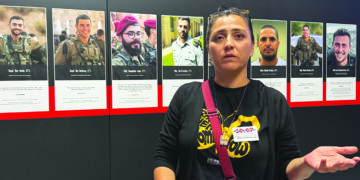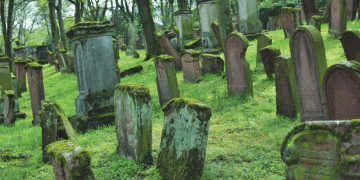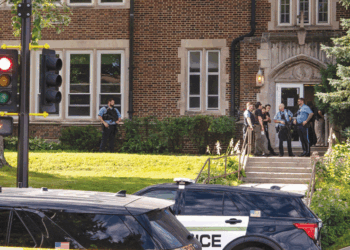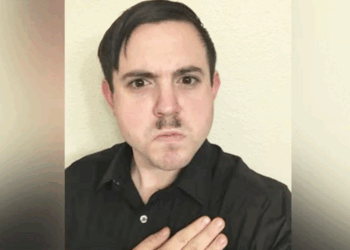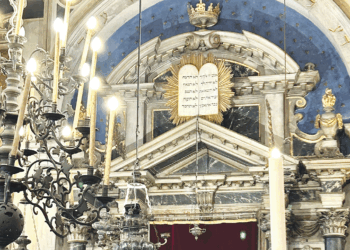It was two weeks of sun, sea, mountains, palm trees, palazzos, piazzas, art galleries, wonderful food and wine: my vacanza in Italia, with my wife, three sons and one girlfriend. Also, some of the Swedish in-laws drove down to see us; we were 13 for one dinner on the patio of the villetta high up in the hills of Tuscany.
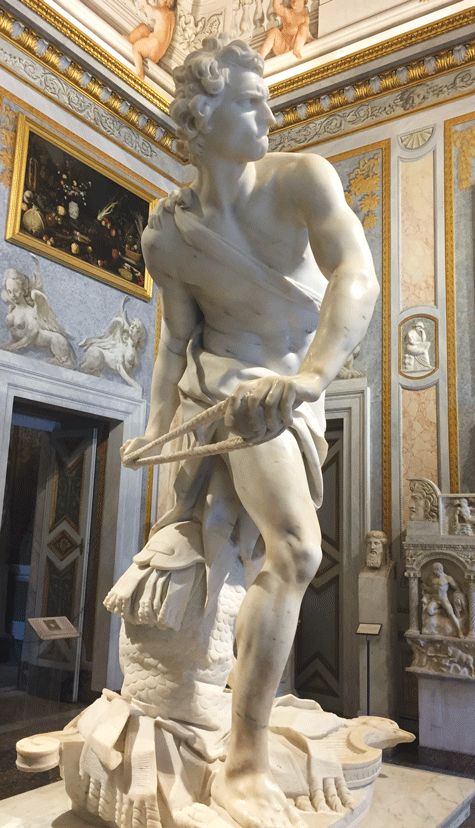
And we spent some days in the charming Trastevere district of Rome, saw the Leaning Tower of Pisa (and the spectacular adjacent cathedral), visited the picturesque walled city of Lucca, and enjoyed a reunion in Trieste with Davide, our foreign exchange student from five years ago.
È un lavoro sporco, ma qualcuno deve farlo, as the Italians might say. It’s a dirty job, but somebody’s got to do it.
For the purposes of this editorial and photo essay, I will focus on some of the Jewish highlights of the trip.
After landing at Leonardo da Vinci Airport near Rome, we took a train and a taxi cab to our little hotel in Trastevere, a bohemian area across the Tiber River from many of the Eternal City’s popular attractions. Actually, Trastevere has become popular with students and tourists, and there’s a wealth of boutiques, restaurants and gelaterias along the district’s narrow, alley-like streets.
A short walk across the Tiber took us to the Jewish Quarter and Rome’s Great Synagogue. When I last visited this area, in 1978, it looked grim. I remember the anti-Israel graffiti and a palpable sense of fear in the neighborhood. That was the time of Red Brigades terrorism. Among other events that transpired during that visit to Italy, the Christian Democratic leader Aldo Moro was kidnapped, and his body later was discovered in the trunk of a car parked near Rome’s Piazza Argentina.
However, in 2017, the Jewish Quarter is a hip spot, with at least a half dozen kosher restaurants open on Via del Portico d’Ottavia, near the synagogue. I was told that politicians and civic leaders frequent the kosher ristoranti.
On our return to Rome, we dined at Ba’Ghetto, which advertises “the best Jewish style artichoke and Roman-Jewish specialities, glatt kosher.” Carciofi alla Giudia, fried artichoke heart, was a revelation. I’m going to try to make it at home one of these days; you can Google the recipe. Ba’Ghetto (baghetto.com) also had delicious pasta dishes — of course, with the tagliatelle in stewed meat sauce, you can’t top it with parmesan cheese. Those are the rules.
In our first sojourn in Rome, we visited the Vatican Museums and the Sistine Chapel. (Buy tickets online and you can jump the queue that stretches for several blocks.) The Italians are quite fond of a Jew from Nazareth, and paintings depicting his life, and afterlife, are a staple of the Vatican picture gallery, and churches and cathedrals around the country.
The line to enter the fabulous Basilica of St. Peter in the Vatican City — the smallest country in the world — was too long to endure. Instead, we visited an exhibit just off St. Peter’s Square, “The Menorah: Worship, History and Myth” — the first-ever joint exhibition between the Vatican Museums and the Jewish Museum of Rome.
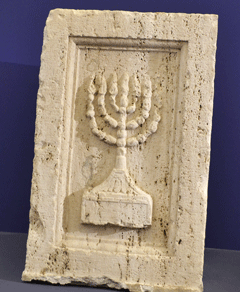
The exhibit traces the history of the menora, the ancient symbol of the Jewish people, with a focus on the mythic solid-gold menora that was looted by Roman forces from the Second Temple in Jerusalem. That menora, carried in a procession through ancient Rome, is depicted on a frieze decorating the Arch of Titus in the Roman Forum. Maybe two other people were enjoying the exhibit with us, in the air-conditioned Carlo Magno gallery. On display were menoras from various eras, along with sculptures, paintings and manuscripts depicting the menora, which also ended up on the official seal of the modern State of Israel.
Prior to jetting off to Italy, I was in touch with Ruth Ellen Gruber, an author and journalist who is one of the eminent authorities on Jewish issues in Europe. Her 1992 book, Jewish Heritage Travel: A Guide to Eastern and Central Europe, has gone through several printings. She lives in a small town near Orvieto, Italy. After some back and forth, we decided that she would drive to our rented villa in Tuscany, and we would finally meet in person.
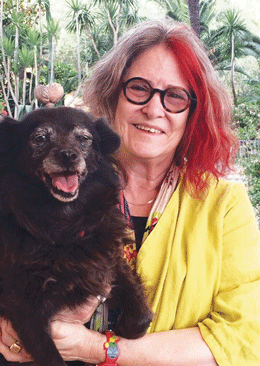
On a Friday afternoon, Ruth Ellen showed up for lunch and a chat. We ended up spending four hours on the patio, discussing what’s what with Europe and the Jews, the hardships of journalism and other topics. Regarding our tentative plan to visit Trieste and Venice, Ruth Ellen suggested that a visit to nearby Ljubljana and some other towns in Slovenia would be more rewarding than wading through throngs of tourists in Venice. She also recommended seeing the synagogue in Trieste, which is one of the largest in Europe, and suggested seeking out Rabbi Ariel Haddad, a Chabad rabbi living in Trieste who serves as the chief rabbi of Slovenia.
As it turned out, when Davide’s parents, Mario and Elisabetta, booked our tour of the Trieste synagogue, the tour guide was Rabbi Haddad, who was born in Italy, lived in Brooklyn and now commutes from Trieste to Ljubljana, where he leads Shabbat services.
An English-language booklet about the Jewish community in Trieste mentions that there were as many as four synagogues in the city’s Jewish ghetto and on Via del Monte. In the late 19th century, the community hatched a plan “to concentrate the different religious rites to a single majestic location, which would reflect the community’s prosperity and equality with the gentiles…”
The current synagogue — Tempio Israelitico di Trieste, in Italian — which was inaugurated in 1912, is said the be the largest in Italy, and one of the largest in all of Europe. It was designed to serve a community that numbered more than 6,000 Jews, in 1938. Rabbi Haddad said that the community has dwindled now to around 800 members. Services take place a few days a week and on holidays.
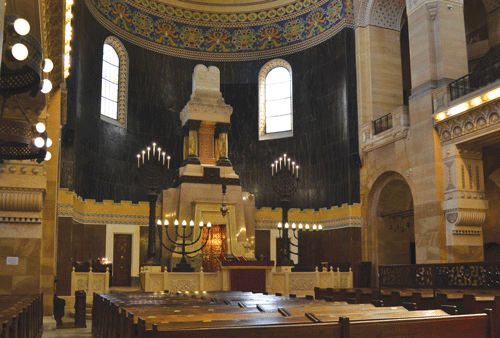
The interior of the synagogue, which survived the ravages of the fascists and Nazis in the previous century, reflects the Italian basilica design, with three naves and four massive pillars supporting the highly decorated dome. Ringing the base of the dome, a colorful ornamental painting depicts the Seven Species of the Holy Land. A balcony for women is no longer used; a mechitza (divider) now separates men and women in the pews.
During a chat with Rabbi Haddad after the tour, he glumly reflected on the diminished attendance at the shul, and the general drift away from Judaism in Trieste. He alluded to those Jews agitating for discussions of social issues in the synagogue, and affirmed that the traditional form of worship would continue. It seemed like a case of the long-running conflict between piety and ethics.
In the late 17th century, the Triestini Jews were confined to a ghetto, which is now part of the tourist itinerary, as is the Carlo e Vera Wagner Museum, which was featuring an exhibition titled “Jewish Geniuses,” portraits of Jews by Andy Warhol. The late pop artist’s portrait of Franz Kafka was featured on the posters for the exhibit tacked up around town.
The Jewish itinerary in Trieste also includes the Risiera di San Sabba, also known as the Risiera Concentration Camp. This holy ground where hundreds of Jews and partisans were murdered by the Nazis is now a memorial and museum.
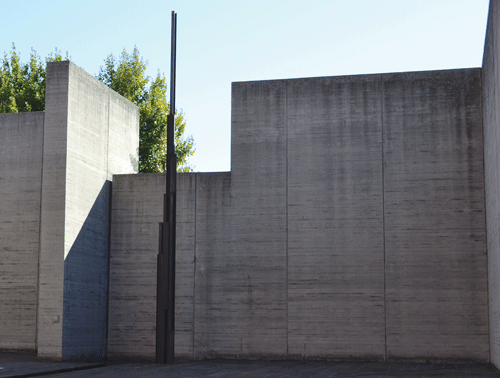
The Risiera, the only Italian concentration camp that had a crematorium, is now a national monument, a place for reflection on the dirty crimes of the fascist and Nazi regimes, and their Italian and Slovenian collaborators. The repression was especially cruel in this part of Italy: Nearly a quarter of all the Jews deported from Italy to Dachau, Auschwitz and other camps to the north were from the Adriatic Littoral, Trieste and surrounding towns, and from the nearby Veneto region.
I was 5,000 miles away from the United States and the mess that is our politics; but in the Risiera, a former rice husking factory, I pondered how a fascist regime takes root and how a people loses its sense of shared humanity. Europe has never been good in dealing with “the other,” especially in the case of its Jewish minority, which has suffered discrimination, dispossessions, depredations and the Shoah, the greatest mass murder of the 20th century. Now, in the face of a refugee crisis, fences and border controls are being imposed across the European continent, as right-wing nationalists vie for political power.
We should not delude ourselves into thinking that it can’t happen here. Under the rubric of terrorism or in the face of a serious economic decline, authoritarian figures could lead the U.S. into a regime of foreign wars and domestic repression. We have a president who habitually lies and displays a complete disregard for democratic norms. He attacks the press, the judiciary and his own partisans, and denigrates religious and ethnic minorities, and women, in the crudest terms. Italy once had a leader like this. His name was Benito Mussolini and he declared that he would make Italy great again.
In the U.S., in the 21st century, we can’t make a mistake like the one the Italians made decades ago. We have to guard against the lure of simple solutions to complex problems. And we have to stand with those communities that are under attack in this country. A bomb is thrown into a mosque in Bloomington; next time the target could be a synagogue somewhere in the Twin Cities.
After a wondrous vacation in Italy, it’s back to reality.
— Mordecai Specktor / editor [at] ajwnews [dot] com
(American Jewish World, 8.11.17)



